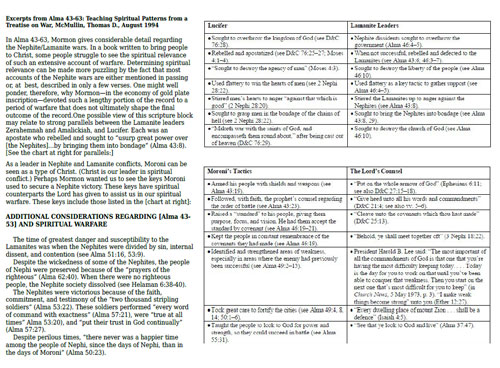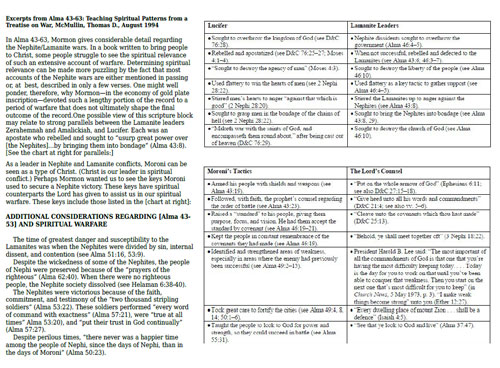Believe it or not, I can totally sum up the rest of Alma in one blog post. Since last I posted we’ve had Seminary less than 10 times. Last week we met only once due to another snowstorm and another freezing rain event. At this point I can’t even remember which days we met and which we didn’t without looking at our attendance sheets, which I have ignored entering in the computer because it’s so depressing. School was canceled so late twice last week that kids showed up for Seminary and let themselves into my house or were locked out. It’s been ridiculous. And we were supposed to have another two day ice storm this weekend, but it looks like now it’s going to be at the beginning of next week. This has been worst winter that even my 83-year old aunt can remember. I don’t know what the schools are going to do, but it’s time for Virginia’s governor to intervene and drop or eliminate the number of school days requirement for this year.
I spoke with Sister O, and we have decided not to extend Seminary even if the school year extends. My students are still right on track, though we’ve had to consolidate some lessons beyond what I would have preferred. It’s so unfortunate that we missed so many days during the Alma 32-36 sections and war chapters. Those are my favorite bits. I am looking for ways to slip in some stuff we’ve had to skip over in later lessons, like tomorrow I’m pulling in Alma 34 to Alma 59-61 (Captain Moroni’s nastygram to Pahoran).
I’ll try to think back over some of the things we’ve done, but frankly, my lesson plans are mostly xs and short notes jotted in the manual and they may be hard to understand.
Alma 37-38
I did use the small and simple things/big impact graphic from the manual, though I remember it wasn’t particularly effective in practice. I had to combine a bunch of stuff and hit highlights here and it just didn’t gel.
The handout at the end of Alma 38 was good. I had planned to use this but had to cut it out. I had also planned to have students do a character study of Shiblon (he’s pretty great), but that had to be cut out, too.
It’s hard to remember what I actually taught since I have so many lesson plans that never actually got taught…..
Alma 39
I was still smarting from the Alma 32 nightmare, and I wasn’t much looking forward to this lesson. It turned out much better than I had feared. There are no notes in my manual. I assume that I decided the manual wasn’t going to work for this lesson, because instead I have my copy of Teaching the Book of Mormon Volume Two all marked up, and I taught from that text. I read the supplemental quote from the manual by Elder Holland (available in the online version) and decided to use that entire talk. Personal Purity by Elder Holland is an amazing talk. I played the youtube video of the talk in one window and in a window next to it I displayed the talk text. I find this is a really effective way to help students follow along with a longer talk. They can both SEE and HEAR the words, and as something I feel is important is said, I highlight it with my mouse to give it more emphasis. Try this out sometime — it’s a super great method if you can get the windows to work right.
You can see my post about that at the LDS Seminary Teachers Facebook group.
So basically I talked about the important phrases in Alma 39:4 “this was no excuse for thee” and in v5 (the ranking of the three worst sins).
I used a quote from the TtBoMII that says “Clearly God’s greatest concerns about mortality are how one gets into this world and how one gets out of it.” I talked a bit about how it may be hard for a younger sibling to feel compared to an older sibling like Corianton was, but I think that Alma was setting Corianton to get the best advice possible from reliable sources. This would have been even more effective if I could have done the character study of Shiblon earlier, but alas, it was not to be. I asked the kids to think of reliable sources they have for getting advice about things. Bishops, parents, teachers, etc.
My own son has recently struggled with sexual sins lately, and so I had to be careful how I tread here. He needs to know that his sins are serious, but that there’s hope. I put a special emphasis on repentance. Alma’s basically telling Corianton:” You can’t undo it, so here’s how to get past it.” in vv 9, 13.
I showed the Holland video at the end, and it was a win, IMO.
Alma 40
For Alma 40, I opened with a quote from TtBoMII where President Monson used a passage from this scripture to comfort the family of a man who was dying. I told the kids this was an important section for understanding the spirit world, and I used the ready-made handout for this lesson linked to from the manual and passed out the short lesson ideas to companionships. I did it a little bit differently than the manual because my class is so big. I assigned each companionship a letter, and after the pair prepared their lessons, they grouped by letter to teach in a small group of 6 to share their lessons. This is a variation of Jigsaw.
I can’t say that this went very well. I found students taught their material, but in seconds instead of participating in a meaningful discussion. My son told me later that I didn’t give clear enough instructions. That’s probably so. Next time….
The Monson quote was effective, and I was able to bring the things we learned back to that well.
Alma 41
Didn’t get to cover this at all. I had hoped to fit it in for a flex day, but those ended up canceled or taken up with catchup, too. I’ll find a hole for this later in the year or as a short lesson before our March Madness playoffs.
Alma 42
I taught this lesson on Justice and Mercy from the manual, and it was not my favorite. I did show a movie called The Mediator, even though I knew it had a doctrinal flaw (pointed out in the comments on the youtube version) in that we don’t have to “pay back” the Mediator. We can’t. Jesus has paid the price so that we don’t have to stay trapped in our sins, because we are unable to fix them or move on. God was watching out for me this day, too, because it was my INVESTIGATOR that questioned me on the doctrinal flaw, even without seeing it! My internet was being yuck, so I cut off the video and started explaining it just before the doctrinally iffy bit (even though I had actually planned to show the whole thing). And to my SHOCK, one of my NeverParticipators answered my question about what the Mediator wants from us when no one else could. I was thrilled!
The video was the only successful thing about this lesson. Just be careful about the paying back bit.
The honest truth is that I feel like I can not teach strictly from the manual and do well. I do try hard, and things have been so horrible here lately that I’ve had to use the manual to fudge a few times when I’ve been playing triage, but blech. I hate the manual more and more as I have to use it. I get that the whole point is that it’s formulaic — I’ve attended both classes by the curriculum writer in our area, and I think I understand what they’re trying to do with the manual. But good grief, the questions are so painful and the progression is so tedious. I feel like I’m dying. Where is the excitement and enthusiasm about the gospel? And so help me, those bolded statements are putting me over the edge. Who am I to tell the kids what to take out of a lesson? If I ask the kids “What do you think?” and then proceed to accept answers and correct them with a bolded statement preceded by the instruction “Ensure students state the following truth in their answers…”, it’s the same thing as telling them that their ideas are wrong. That method will, over time, result in less and less participation. It really torques me.
Alma 43-53
I should have known better. This was another lesson I taught from the manual (Alma 45-48, most of the fortifications stuff just had to be dropped due to time). It sucked. My manual is all marked up and I included points from our previous lessons, cut out the crap that assumes the kids don’t read, and it was still crap. I had cut out some paper cloaks for the kids to tear and then write their own title of liberty on, and they wrote junk. Again, possibly poor instructions by me.
Now, I think if you asked the kids what they thought, they’d say it was fine. But I’m not going for fine. I’m looking for a well thought out, cohesive lesson that makes one or two essential points strongly. The manual has too much bolding. Too many questions. And not enough fun. Nothing that ties the lesson together into a single pithy statement so that the kids can tell you “what they learned”.
Anyway, I spend a good bit of time helping the kids understand the war stories. I used a handout I made based on a paper on the SI website to help students understand why there is so much warfare in the BoM [BELOW]. In retrospect, this would be a helpful theme to introduce at the beginning of Alma to help kids begin to see these patterns themselves, rather than a review. But the snow….. Anyway, I’ve been referencing the idea that the war chapters can be seen as showing patterns of how we can fight evil in our own daily battles. It seems to be sinking in.
Then I introduced March Madness and gave them a review quiz from the Introduction to the BoM through Enos to start off the fun.
Looking back, this was definitely two lessons, but I’m not sure where the division was…. the snow has me bumfuzzled.
Alma 54-58
I taught all these chapters together in a single day even though I had it broken up into two, thanks to the snow. Now after all my ranting, I have to admit here that the manuals method of breaking up the important scriptures up into “before” and “during” the battle made a lot of sense. I had already picked out my emphasis scriptures, and the manual used the same ones but grouped in this way, which made a lot of sense. So I dropped my regular jumping around cross-referencing bit in favor of the manual’s drawing. I didn’t teach it the way the manual said, though. I just drew the warrior with before and during, and then wrote the scriptures underneath each header. We read the scriptures, and I had the kids list the traits they discovered. I also had them find what the mothers taught the boys (Alma 24:16,19) They did a great job. This is a familiar story, so it’s easy to teach.
When I was younger I thought that the message was “believe really hard and God will protect you from death”, but now I think the real message is FAITH + OBEDIENCE/EXACTNESS = DELIVERANCE — and deliverance may not be more time on earth. It’s eternal life. The Stripling Warriors would have won even if they had all died, because they had faith in Christ and were trying to obey with exactness.
My investigator had not read in preparation for this class, and she said she was wishing she had, because the discussion and content was pretty great.
To conclude I taught something that wasn’t in the manual at all, sadly, from Alma 58:9–13. It has a pattern for dealing with fear in our lives. I have labeled each verse with these keywords:
- v9 – fear
- v10 – prayer
- v11 – peace
- v12 – believe/courage
- v13 – take action
This is what I love about the war chapters: it’s real people in difficult circumstances figuring out how to maintain their integrity even when they’re afraid or may even die. I LOVE LOVE LOVE LOVE LOVE this section and I’m sorry it has been cut short.
My frustration with the school schedule is probably as much to blame for my general sense of being “off” as anything.



